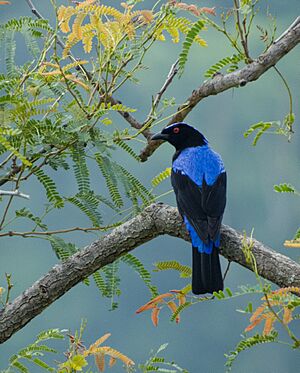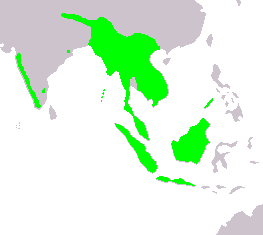Asian fairy-bluebird facts for kids
Quick facts for kids Asian fairy-bluebird |
|
|---|---|
 |
|
| Male in Marayoor, Kerala India | |
 |
|
| Female in Mount Harriet National Park, Andaman and Nicobar Islands | |
| Conservation status | |
| Scientific classification | |
| Genus: |
Irena
|
| Species: |
puella
|
 |
|
| Range includes I. tweeddalii | |
| Synonyms | |
|
Coracias puella |
|
The Asian fairy-bluebird (Irena puella) is a beautiful medium-sized bird that lives in trees. You can find these birds in forests across warm parts of southern Asia, including Indochina and the Greater Sunda Islands. They build small cup-shaped nests in trees and usually lay two or three eggs. A British bird expert named John Latham first described this species in 1790.
The only other bird in the same family is the Philippine fairy-bluebird. It lives in most of the Philippines instead of the Asian fairy-bluebird. Both types of fairy-bluebirds are special to the Tagalog people. They see these birds as good omens, which are signs of future events.
Adult Asian fairy-bluebirds are about 24 to 27 centimeters (9.4 to 10.6 inches) long. The male birds have shiny, bright blue feathers on their backs and black feathers on their undersides and wings. Female birds and young males are a dull blue-green color all over. These birds eat fruits, nectar from flowers, and some insects. Their call sounds like a soft, two-note glue-it.
Contents
About the Asian Fairy-Bluebird
The Asian fairy-bluebird is about 24 to 27 cm (9.4 to 10.6 in) long. Its eyes are red, and its eyelids are a bit pink. The beak, legs, and claws are black.
Male and Female Differences
Male and female Asian fairy-bluebirds look very different. This is called sexual dimorphism.
- Male Birds: The male is a shiny, bright blue color on its upper body, including its back and some wing feathers. It has a deep black color on the sides of its head and all of its lower body. Its main wing and tail feathers are also black. Some of its wing feathers have blue tips, and the middle tail feathers have a blue shine.
- Female Birds: The female's upper body, including some wing and tail feathers, is a brownish-blue. The edges of these feathers are a bit brighter. Her main wing and tail feathers are dark brown. The sides of her head and her whole lower body are blue, similar to her upper parts.
- Young Birds: Young birds look like the females.
Male birds change into their adult colors around March without shedding their feathers. First, the feathers on their upper body get bright blue edges. Then, their tail feathers change, and finally, their lower body feathers turn black. You can often see young birds with a mix of black and dull blue on their lower bodies, and their upper bodies already look like an adult male's.
Different Types of Asian Fairy-Bluebirds
There are several types, or subspecies, of Asian fairy-bluebirds. For example, the I. cyanea malayensis from the Malay Peninsula has longer feathers under its tail that almost reach the tip of the tail.
Where They Live and Their Home
The Asian fairy-bluebird lives in many places across Asia.
- India and Sri Lanka: You can find them in Sri Lanka and along the western coast of India, from Travancore up to Shivamogga, Belgaum, and Sawantwadi. They also live in Sikkim and the lower parts of the Himalayas, reaching Dibrugarh in Assam. Other areas include the Khasi Hills, Cachar, and Manipur.
- Southeast Asia: They are common in Bangladesh, Arrakan, Bago and Taninthayi Division in Burma, and the Andaman and Nicobar Islands. In Southeast Asia, they live throughout most of Indochina (including Peninsular Malaysia), Sumatra, Borneo, Java, and smaller islands nearby.
In India, these birds mostly stay in the evergreen forests of hills and plains. In other places, they live in different kinds of humid and deciduous forests, from lowlands up to about 1,600 meters (5,200 ft) high. They are often found in old rainforests and cardamom farms that have native shade trees.
The type of fairy-bluebird found in Palawan is now considered a separate species. It is called the Palawan fairy-bluebird (I. tweeddalii).
Life and Habits
These birds are common in the areas where they live. They often move around in small groups or in pairs.
Breeding and Nests
Asian fairy-bluebirds lay eggs from February to April. They build a shallow, cup-shaped nest, sometimes using moss or small twigs. They place these nests in young trees or small trees. They usually lay two eggs, which are greenish-white with brown marks. Each egg is about 1.14 cm by 0.77 cm (0.45 in by 0.30 in).
What They Eat
These birds mainly eat fruit. You can usually find them on larger forest trees, looking for food.
Gallery



